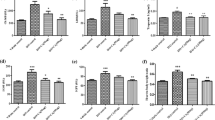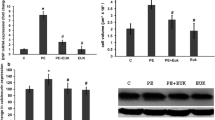Abstract
The cardioprotective properties of new pharmaceuticals such as carvedilol might be explained by enhanced mitochondrial protection. The aim of this work was to determine the role of carvedilol in the protection of heart mitochondria from oxidative damage induced by hypoxanthine/xanthine oxidase, a known source of oxidative stress in the vascular system. Carvedilol reduced oxidative-stress-induced mitochondrial injury, as seen by the delay in the loss of the mitochondrial transmembranar potential (ΔΨ), the decrease in mitochondrial swelling, and the increase in mitochondrial calcium uptake. Carvedilol improved the mitochondrial respiratory activity in state III and offered an overall protection in the respiratory control and in the P/O ratios in mitochondria under oxidative stress. The data indicated that carvedilol was able to partly protect heart mitochondria from oxidative stress-induced damage. Our results suggest that mitochondria can be important targets for some cardioprotective pharmaceuticals.
Similar content being viewed by others
References
Ferrari, R. (1996). The role of mitochondria in ischemic heart disease. J. Cardiovasc. Pharmacol. 28(Suppl. 1): S1-S10.
Di Lisa, F., Menabò, R., Canton, M., and Petronilli, V. (1998). The role of mitochondria in the salvage and injury of the ischemic myocardium. Biochim. Biophys. Acta 1366: 69–78.
Baker, J.E., Felix, C.C., Olinger, G.N., and Kalyanaraman, B. (1988). Myocardial ischemia and reperfusion: direct evidence for free radical generation by electron spin resonance spectroscopy. Proc. Natl. Acad. Sci. USA 85:2786–2789.
Ward, A., McBurney, A., and Lunec, J. (1994). Evidence for the involvement of oxygen-derived free radicals in ischemia-reperfusion injury. Free Radic. Res. Commun. 20:21–28.
Ferrari, R., Agnoletti, L., Comini, L., Gaia, G., Bachetti, T., Cargnoni, A., et al. (1998). Oxidative stress during myocardial ischemia and heart failure. Eur. Heart J. 19: B2-B11.
Giron-Calle, J., Zwizinski, C.W., and Schmid, H.H.O. (1994). Peroxidative damage to cardiac mitochondria—II. Immunological analysis of modified adenine nucleotide translocase. Arch. Biochem. Biophys. 315:1–7.
Crompton, M. and Costi, A. (1990). A heart mitochondrial Ca2+-dependent pore of possible relevance to reperfusion-induced injury. Biochem. J. 266:33–39.
Halestrap, A.P., Kerr, P.M., Javadov, S., and Woodfield, K-Y. (1998). Elucidating the molecular mechanism of the permeability transition pore and its role in reperfusion injury of the heart. Biochim. Biophys. Acta 1366:79–94.
Jurado, F., Bellon, J.M., Pareja, J.A., Golitsin, A., Millán, L., Pascual, G., et al. (1998). Effects of ischemia-reperfusion and cyclosporin-A on cardiac muscle ultrastructure. Histol. Histopathol. 13:761–774.
Hendrickson, S.C., St. Louis, J.D., Lowe, J.E., and Abdel-Aleem, S. (1997). Free fatty acid metabolism during myocardial ischemia and reperfusion. Mol. Cell Biochem. 166:85–94.
Maulik, N., Yoshida, T., and Das, D.K. (1999). Regulation of cardiomyocyte apoptosis in ischemic reperfused mouse heart by glutathione peroxidase. Mol. Cell. Biochem. 196:13–21.
Ruffolo, R.R., Jr., Boyle, D.A., Brooks, D.P., Feuerstein, G.Z., Venuti, R.P., Lukas, M.A., et al. (1992). Carvedilol, anovel cardiovascular drug with multiple actions. Cardiovasc. Drug Rev. 10:127–157.
Dunn, C.J., Lea, A.P., and Wagstaff, A.J. (1997). Carvedilol—a reappraisal of its pharmacological properties and therapeutic use in cardiovascular disorders. Drugs 54: 161–185.
Yue, T-L., Cheng, H-Y., Lysko, P.G., McKenna, P.J., Feueustein, R., Gu, J-L., et al. (1992). Carvedilol, a new vasodilator and beta adrenoceptor antagonist, is an antioxidant and free radical scavenger. J. Pharmacol. Exp. Ther. 263:92–98.
Yue, T-L., McKenna, P.J., Ruffolo, R.R. Jr., and Feuerstein, G. (1992). Carvedilol, a new b-adrenoceptor antagonist and vasodilator antihypertensive drug, inhibits superoxide release from human neutrophils. Eur. J. Pharmacol. 214:277–280.
Moreno, A.J.M., Santos, D.L., and Palmeira, C.M. (1998). Ischemic heart disease: the role of mitochondria—carvedilol prevents lipid peroxidation of mitochondrial membranes. Rev. Port. Cardiol. 17:II-63–II-77.
Oliveira, P.J., Santos, D.L., and Moreno, A.J.M. (2000). Carvedilol inhibits the exogenous NADH dehydrogenase in rat heart mitochondria. Arch. Biochem. Biophys. 374: 279–285.
Nohl, H., Koltover, V., and Stolze, K. (1993). Ischemia/ reperfusion impairs mitochondrial energy conservation and triggers O *−2 release as a byproduct of respiration. Free Radical Res. Commun. 18:127–137.
Takeyama, N., Matsuo, N., and Tanaka, T. (1993). Oxidative damage to mitochondria is mediated by the Ca2+-dependent inner-membrane permeability transition. Biochem. J. 294:719–725.
Broekemeier, K.M., Dempsey, M.E., and Pfeiffer, D.R. (1989). Cyclosporin A is a potent inhibitor of the inner membrane mitochondrial transition in liver mitochondria. J. Biol. Chem. 264:7826–7930.
Kamo, N., Muratsugu, M., Hogoh, R., and Kobatake, Y. (1979). Membrane potential of mitochondria measured with an electrode sensitive to tetraphenyl phosphonium and relationship between proton electrochemical potential and phosphorylation potential in steady state. J. Membr. Biol. 49:105–121.
Rajdev, S. and Reynolds, I.J. (1993). Calcium Green-5N, a novel fluorescent probe for monitoring high intracellular free Ca2+ concentrations associated with glutamate excitotoxicity in cultured rat brain neurons. Neurosci. Lett. 162: 149–152.
Halliwell, B. (1975). The superoxide dismutase activity of iron complexes. FEBS Lett. 56:34–38.
Oliveira, P.J., Marques, M.P.M., Carvalho, L.A.E.B., and Moreno, A.J.M. (2000). Effects of carvedilol on isolated heart mitochondria: evidences for a protonophoretic mechanism. Biochem. Biophys. Res. Commun. 276:82–87.
Eddy, L.J., Stewart, J.R., Jones, H.P., Engerson, T.D., McCord, J.M., and Downey, J.M. (1987). Free radical-producing enzyme, xanthine oxidase, is undetectable in human hearts. Am. J. Physiol. 253:H709-H711.
Saksela, M., Lapatto, R., and Raivio, K. (1999). Irreversible conversion of xanthine dehydrogenase into xanthine oxidase by a mitochondrial protease. FEBS Lett. 443:117–120.
Oliveira, P.J., Coxito, P.M., Rolo, A.P., Santos, D.L., Palmeira, C.M., and Moreno, A.J.M. (2000). Inhibitory effect of carvedilol in the high-conductance state of the calcium-sensitive mitochondrial permeability transition pore. Eur. J. Pharmacol. 412 (3):231–237.
Zago, E.B., Castilho, R.F., and Vercesi, A.E. (2000). The redox state of endogenous pyridine nucleotides can determine both the degree of mitochondrial oxidative stress and the solute selectivity of the permeability transition pore. FEBS Lett. 478:29–33.
Halestrap, A.P. and Davidson, A.M. (1990). Inhibition of Ca2+-induced large-amplitude swelling of liver and heart mitochondria by cyclosporin is probably caused by the inhibitor binding to mitochondrial-matrix peptidylprolyl cis-trans isomerase and preventing it interacting with the adenine nucleotide translocase. Biochem. J. 268: 153–160.
Pruett, J.K., Walle, T., and Walle, U. (1980). Propranolol effects on membrane repolarization time in isolated canine Purkinje fibers: threshold tissue content and the influence of exposure time. J. Pharmacol. Exp. Ther. 215:539–543.
Neugebauer, G., Akpan, W., Mollendorff, E.V., Neupert, P., and Reif, K. (1987). Pharmacokinetics and disposition of carvedilol in humans. J. Cardiovasc. Ther. 10(Suppl. 11): S85-S88.
Author information
Authors and Affiliations
Corresponding author
Rights and permissions
About this article
Cite this article
Oliveira, P.J., Rolo, A.P., Palmeira, C.M. et al. Carvedilol reduces mitochondrial damage induced by hypoxanthine/xanthine oxidase. Cardiovasc Toxicol 1, 205–213 (2001). https://doi.org/10.1385/CT:1:3:205
Issue Date:
DOI: https://doi.org/10.1385/CT:1:3:205




